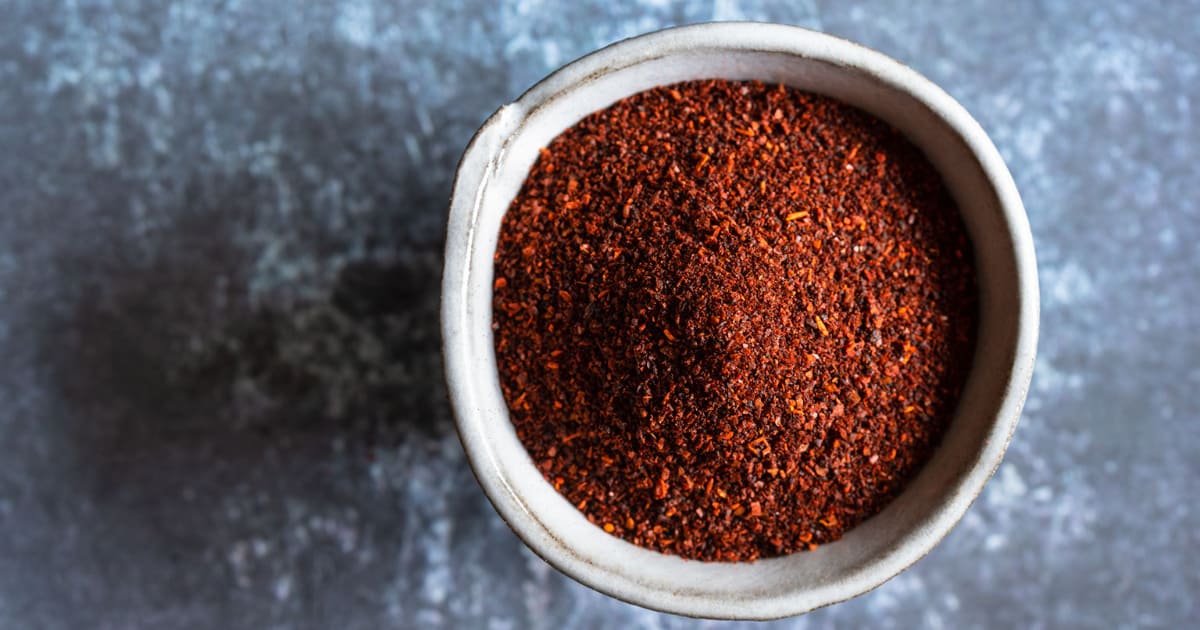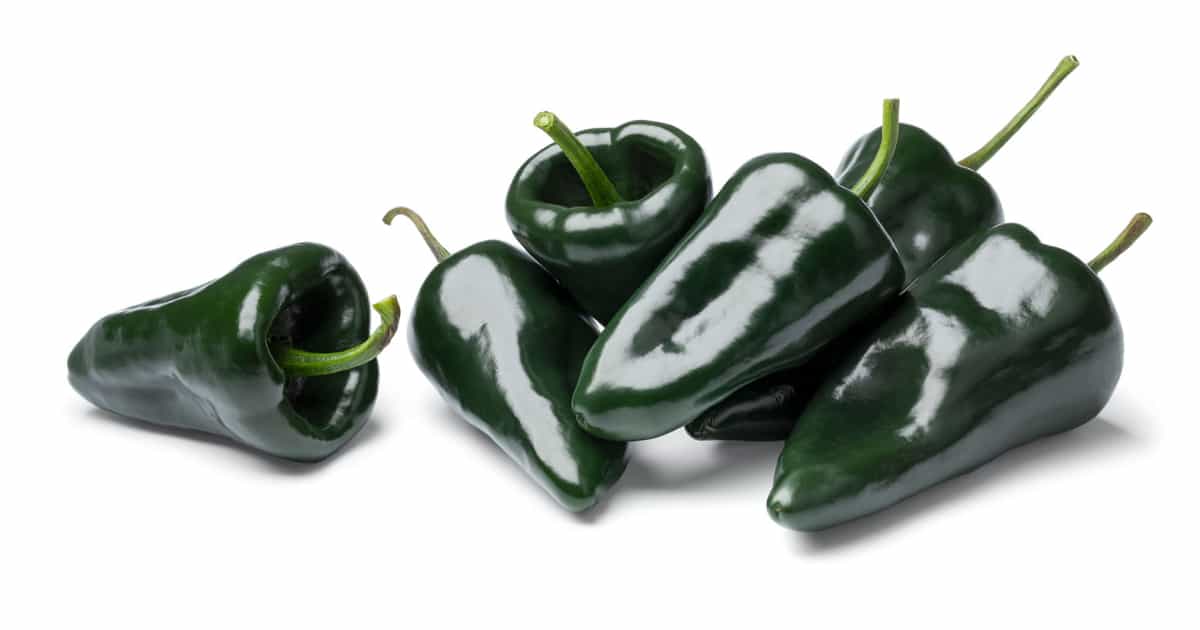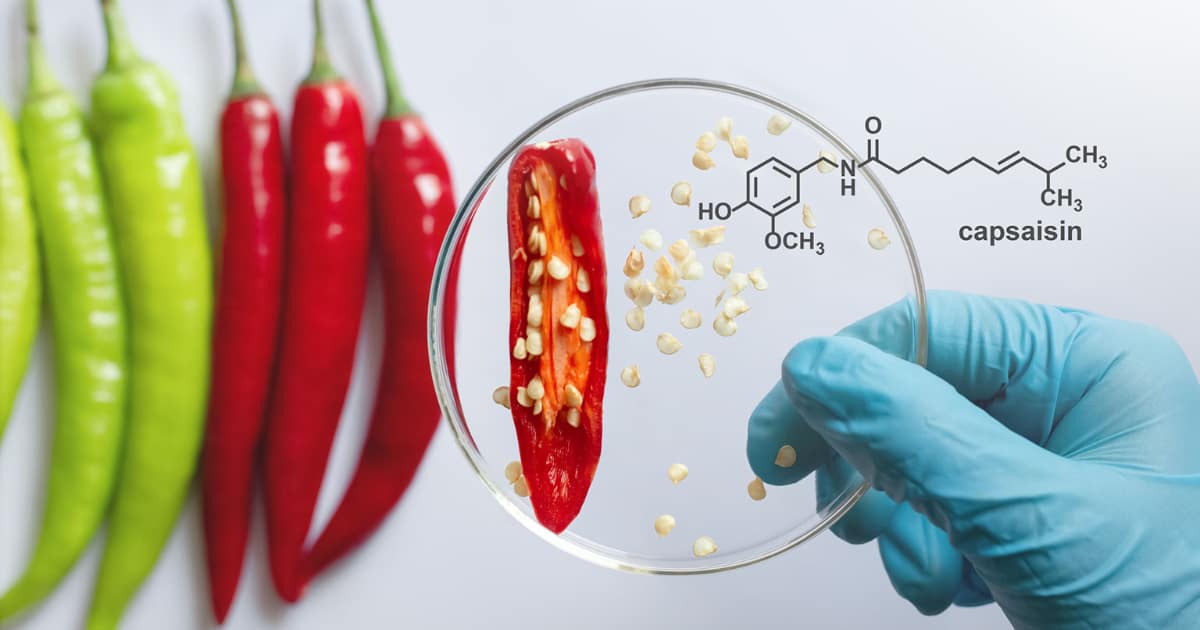Ancho chili powder is a pure chili powder made only from dried ancho peppers with no other ingredients added.
Ancho peppers are ripened poblano peppers that have been dried. They have a dark reddish-brown color and a wrinkled texture. They are one of the most common dried chiles used in Mexican cuisine.

Ancho chili powder has a mild to medium heat level, ranging from 1,000 to 2,000 Scoville heat units.
It has a sweet, fruity, and slightly smoky flavor that adds depth and complexity to dishes.
History and Origin of Ancho Chili Powder
Ancho chili powder originates from Mexico, where poblano peppers are native. The Aztecs and other Mesoamerican civilizations cultivated these peppers for thousands of years. They were named after Puebla, where they are still widely grown today.
The peppers are harvested when they are green and immature. When they ripen, they turn red and become sweeter and softer. The red poblanos are then dried to make ancho chiles. The drying process enhances their flavor and preserves them for more extended storage.
The Ancho chiles were introduced to Europe by Spanish explorers in the 16th century. They became popular in Spain and Portugal, where they were used to make sauces and stews. They also spread to other parts of the world, such as India, China, and Africa.
The Making of Ancho Chili Powder

The poblano peppers are dried in the sun or a dehydrator until they become flat, wrinkly, and dark brown. Once dried, they are ready to be ground into powder.
The stems and seeds are removed from each pepper, and the peppers are torn into smaller pieces.
The pieces are then added to a spice grinder or a blender and blended until they form a fine powder.
The powder can be sifted to remove large chunks that did not grind well.
Homemade Ancho Chili Powder: A Step-by-Step Guide
Making your ancho chili powder is easy and inexpensive, giving you more control over the quality and flavor of your spice.
Here is a simple guide to making it yourself:
- Buy fresh poblano peppers from a grocery store or a farmers market. Look for peppers that are firm, glossy, and dark green.
- Ripen the peppers by placing them in a paper bag and storing them in a warm place for a few days until they turn red.
- Dry the peppers by spreading them on a baking sheet and placing them in an oven at the lowest temperature for several hours or until completely dry and brittle. Alternatively, you can use a dehydrator or dry them in the sun.
- Grind the peppers by removing the stems and seeds, tearing them into pieces, and blending them in a spice grinder or a blender until they form a fine powder.
- Sift the powder through a fine-mesh strainer or a sieve to remove large chunks.
- Store the powder in an airtight container in a cool, dark place for up to a year.
Characteristics of Ancho Chili Powder
Ancho chili powder is typical in Mexican and Southwestern cuisine. It adds depth and richness to dishes without adding too much heat.
It has raisin, plum, and chocolate notes and pairs well with other spices such as cumin, oregano, garlic, and cinnamon.
It is suitable for people who enjoy a subtle hint of spice without burning their tongues.
Nutritional Profile and Health Benefits
Ancho powder is low in calories and fat and high in fiber and vitamin C.
One teaspoon (2 grams) of it provides:
- Calories: 6
- Fat: 0.3 grams
- Carbohydrates: 1.2 grams
- Fiber: 0.4 grams
- Protein: 0.2 grams
- Vitamin C: 6% of the Daily Value (DV)
The powder also contains small amounts of other nutrients, such as vitamin A, iron, potassium, and riboflavin. However, these amounts are not significant in the typical serving size.
Potential Health Benefits

Some of the potential health benefits of ancho chili powder are:
- Relieving pain: Capsaicin, the compound that gives chili peppers their heat, may stimulate the release of endorphins, which are natural painkillers. Capsaicin may also reduce inflammation and pain associated with arthritis, psoriasis, and other conditions.
- Aiding weight loss: Capsaicin may also help with weight loss by increasing metabolism, suppressing appetite, and reducing fat tissue growth.
- Treating intestinal conditions: Ancho chiles contain insoluble fiber, which can help prevent constipation and promote bowel health. Fiber may also lower the risk of diverticulitis, hemorrhoids, and colon cancer.
- Combating prostate cancer: Capsaicin may have anti-cancer effects by inducing apoptosis (cell death) in prostate cancer cells. Studies have shown that capsaicin can inhibit the growth and spread of prostate cancer in mice and humans.
- Fighting heart disease: Ancho powder may also benefit heart health by lowering blood pressure, cholesterol, and triglycerides. Capsaicin may improve blood vessel function and prevent blood clots.
Ancho Chili Powder in a Balanced Diet
Ancho chili powder can be a healthy addition to a balanced diet, as it can enhance the flavor and nutrition of various dishes.
It should be consumed in moderation, as too much capsaicin may cause adverse effects such as stomach irritation, heartburn, diarrhea, or allergic reactions.
Ancho Chili Powder as a Substitute for Other Spices
Ancho chili powder can sometimes be used as a substitute for other spices.
It has a different flavor profile and heat level than other spices, so the result may vary depending on the recipe and personal preference.
Generally speaking, it can replace regular chili powder in equal amounts but may make the dish less spicy and smoky.
It can also replace paprika or cumin in some recipes, but it may alter the color and taste of the dish significantly. A possible ratio is one teaspoon of ancho chili powder for 1/2 teaspoon of paprika or cumin.
Recipes Featuring Ancho Chili Powder
Ancho chili powder is a common ingredient in Mexican cuisine, especially in sauces, stews, and moles.
Here are some examples of how you can use ancho powder in traditional Mexican dishes:
- Mole sauce: Mole is a complex and flavorful sauce that usually contains chocolate, nuts, seeds, spices, and chilies. Ancho chili powder adds depth and richness to the sauce, complementing the other ingredients. Mole sauce can top chicken, turkey, enchiladas, or tamales.
- Chili con carne: Chili con carne is a hearty stew of meat, beans, tomatoes, and spices. Ancho chili powder gives the stew a smoky and slightly sweet flavor that balances the spiciness of other chilies. You can serve chili con carne with cornbread, rice, or tortillas.
- Enchilada sauce: Enchilada sauce is a tomato-based sauce that coats tortillas filled with cheese, meat, or vegetables. Ancho powder adds a subtle heat and a fruity note to the sauce that enhances the flavor of the filling. You can make enchilada sauce with ancho chili powder, tomato sauce, garlic, onion, oregano, cumin, and salt.
Ancho chili powder is not only for Mexican dishes; you can also spice up other cuisines and create new flavors.
Here are some examples of how you can use ancho chili powder in non-traditional recipes:
- Roasted vegetables: Roasted vegetables are a simple and healthy side dish that can be seasoned with different spices. Ancho powder adds a smoky and sweet touch to the vegetables, making them more flavorful. You can toss your favorite vegetables with olive oil, ancho chili powder, salt, and pepper and roast them in the oven until tender.
- Barbecue sauce: Barbecue sauce is a tangy and sweet sauce that goes well with grilled meats and vegetables. Ancho powder adds smoky and mild heat to the sauce, enhancing its flavor. You can make a barbecue sauce with ancho chili powder, ketchup, brown sugar, vinegar, Worcestershire sauce, garlic, onion, mustard, and salt.
- Popcorn: Popcorn is a crunchy and satisfying snack that can be flavored with different toppings. Ancho chili powder adds a spicy and sweet kick to the popcorn, making it more interesting. You can drizzle melted butter over popped popcorn and sprinkle ancho chili powder, salt, and sugar.
DIY Spice Mixes with Ancho Chili Powder
Here are some examples of spice mixes that you can make with ancho chili powder:
Taco seasoning
Combine:
- two tablespoons of ancho chili powder
- one tablespoon of cumin
- two teaspoons of garlic powder
- two teaspoons of onion powder
- one teaspoon of oregano
- one teaspoon of salt
- 1/4 teaspoon of black pepper
Store in an airtight container and use about two tablespoons per pound of meat or beans for tacos.
Chili seasoning
Combine:
- three tablespoons of ancho chili powder
- two tablespoons of paprika
- two teaspoons of cumin
- two teaspoons of garlic powder
- one teaspoon of oregano
- one teaspoon of salt
- 1/2 teaspoon of black pepper
- 1/4 teaspoon of cayenne pepper
Store in an airtight container and use about 1/4 cup per four cups of liquid for chili.
BBQ rub
Combine:
- 1/4 cup of brown sugar
- two tablespoons of ancho chili powder
- two tablespoons of paprika
- one tablespoon of salt
- one tablespoon of black pepper
- one teaspoon of garlic powder
- one teaspoon of onion powder
- 1/2 teaspoon of cumin
Store in an airtight container and use as a dry rub for ribs, chicken, pork, or beef before grilling or smoking.
Common Issues
If you find that your dish is too spicy for your liking after adding ancho powder, don't panic. There are some ways to tone down the heat and balance the flavors.
Here are some tips:
- Add more liquid: Adding more water, broth, tomato sauce, or milk can dilute the spiciness and make the dish milder.
- Add more ingredients: Adding more rice, beans, potatoes, corn, cheese, or sour cream can also help reduce the heat and add bulk to the dish.
- Add some sweetness: Adding some sugar, honey, maple syrup, or molasses can counteract the spiciness and add some complexity to the dish.
- Add some acidity: Lemon juice, lime juice, vinegar, or yogurt can also balance the spiciness and add freshness to the dish.
What to Do if Ancho Chili Powder is Unavailable
If you don't have ancho chili powder in your pantry, don't worry. You can use substitutes to achieve a similar flavor and color in your dishes.
Here are some options:
Regular chili powder
This blend includes a few spices, including ground chilies, cumin, garlic, oregano, and sometimes cayenne pepper.
It is not as sweet or smoky as ancho chili powder, but it will add some heat and complexity to your dish. You can use it in a 1:1 ratio.
Crushed red pepper flakes
These are dried and crushed red chilies with moderate to high heat levels. They will not give you the same sweetness or smokiness as ancho chili powder, but they will add some spiciness and color to your dish.
You can use about 1/4 to 1/2 teaspoon of crushed red pepper flakes for every teaspoon of ancho chili powder.
Chipotle chili powder
This is made from dried and smoked jalapeño peppers with heat and smokiness similar to ancho peppers. They have a fruity and tangy flavor that may not suit every dish.
You can use chipotle chili powder in a 1:1 ratio, but be aware that it will change the flavor profile of your dish.
Paprika
This is made from dried and ground red peppers, which can vary in heat and flavor depending on the variety. Paprika will give you a similar color, but it will not have the same sweetness or smokiness.
You can use paprika in a 1:1 ratio, but you may want to add some sugar or liquid smoke to enhance the flavor.
Handling Storage and Freshness Concerns
Ancho chili powder is best stored in an airtight container in a cool, dark, and dry place.
It will last up to two years if stored properly, but it may lose some flavor and potency over time.
To check if your powder is still fresh, smell it and taste a small amount. It is good to use if it has a strong aroma and flavor. If it smells stale or bland, it is time to replace it.
FAQs
Is Ancho Chili Powder the Same as Chili Powder?
No, they are not the same. Ancho chili powder is made from only one type of chili pepper.
In contrast, chili powder blends different spices, including ground chilies, cumin, garlic, oregano, and cayenne pepper.
Ancho powder has a sweeter and smokier flavor than regular chili powder.
Can I Substitute Cayenne for Ancho Chili Powder?
No, they are not interchangeable. Cayenne pepper is much hotter than ancho pepper and has a different flavor profile.
Cayenne pepper will add too much heat and overpower the other flavors in your dish.
If you still want to substitute cayenne for ancho powder, use only a tiny amount (about 1/8 to 1/4 teaspoon) and adjust the seasoning accordingly.
How Long Does Ancho Chili Powder Last?
Ancho chili powder can last for a long time if stored properly.
According to the USDA, ground spices like ancho chili powder can last 2 to 3 years in a cool, dry, dark place.
However, over time, the flavor and color of the spice may fade. To preserve the quality of ancho chili powder, storing it in an airtight container away from heat, light, and moisture is recommended.
You can also refrigerate or freeze it to extend its shelf life, but seal it well to prevent condensation and freezer burn.
You can smell and taste a small amount to check if it is still good. You should discard it if it has lost its aroma and flavor, changed color or texture, or shown signs of mold or insects.
Is Ancho Chili Powder Suitable for Vegetarian and Vegan Diets?
Ancho chili powder is suitable for vegetarian and vegan diets as it is made from only one ingredient: dried ancho peppers.
The peppers are plant-based and do not contain any animal products or by-products.
However, some brands of ancho chili powder may add other ingredients or use processing methods that are not vegetarian or vegan-friendly.
For example, some products may contain salt, sugar, preservatives, anti-caking agents, or other spices derived from animal sources or tested on animals.
Therefore, it is essential to check the label of it before buying or using it to ensure that it meets your dietary preferences and requirements.
Conclusion
Ancho chili powder is a versatile spice from dried and ground Poblano peppers. It's a key ingredient in Mexican cuisine and adds flavor to dishes worldwide.
Its unique taste balances heat with a rich, mildly sweet, and slightly smoky flavor. It's not as spicy as other chili powders and adds depth to dishes with its appearance and texture.
It also has some nutritional benefits. It contains vitamins and minerals, and its capsaicin content may provide health benefits.
It's essential to many recipes, from traditional Mexican dishes to DIY spice mixes. Other spices can be substitutes, but the flavor may differ slightly.

